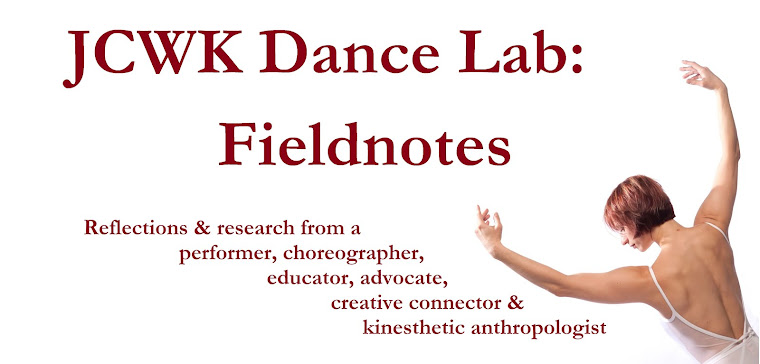I mentioned in Secrets for Dance in Small Spaces - Tip 1 that I've traveled a lot for dance.
Traveling has inspired me to find multiple uses for things that I carry with me. I seek out props, tools and accessories that can have multiple uses. (Check out my Hacks for Dancers in DanceAdvantage.net). For example and in addition, (in a pinch): 1. Lipstick can be used as blush. Slide the lipstick on your cheekbone and blend with your fingers. 2. Shampoo can be used as body wash. Create a lather. 3. Hand sanitizer can be used as a face wash (not makeup remover!). 4. Baby wipes have many uses. 5. As do hair ties (rubber bands), hair pins (paper clips), and hair spray (stop runs in tights on the spot! Or, keep those stray threads or ribbons from fraying more).
 |
| Dance everywhere! |
1. In Tip 1, I suggested focusing movement in one plane. A yoga mat provides a visual guideline for these planes.
2. A yoga mat can be placed on uneven surfaces to provide consistency. Most mats are squishy and a little bit sticky. However, if a dancer is working on carpet, tile, bricks, or some other uneven surface, a yoga mat can provide ground-level consistency and a bit of shock absorption. But! - yoga mats can be sticky. Socks and specific shoes can help mitigate the risks of dancing on a sticky surface. I encourage you to test and try out what works for you.
3. Jumping can be dangerous in ideal circumstances (which include but aren't limited to proper training, sprung floor and adequate shoes). Jumping in small spaces in dangerous. If a dancer has a great desire to jump, a yoga mat can be folded and laid down to provide a soft landing surface for small jump practice. This might include soutes from first and second position, soutes on one foot with the other in pase or coupe, and changemonts. I strongly discourage working on big leaps in a small space. More on that in Tip 3.
I also discourage working on turns in a small space. (Again, stay tuned for Tip 3.)
4. Focus on alignment. The squishiness of a yoga mat can demand that a practitioner focus on alignment. The extra "give" might invite the body to compensate to achieve a particular form. I suggest slowing down (more in Tip 3) to recognize one's personal habits and weaknesses in order to achieve a safe and healthy form and alignment. In regular practice, the body will make these patterns habit and will "revert" to these adjustments when faced with new dance surfaces. This will allow dancing longer and dancing stronger.
5. Make your practice a ritual. In her book, The Creative Habit: Learn It and Use It for Life, Twyla Tharp suggests that a ritual begins with taking an initial step. For some yogi's this begins with rolling out the mat. For some dancers, putting on tights. For you, perhaps rolling down from the top of the spine, reorganizing some furniture, or starting a specific playlist. Once that initial act is started, the rest will organically fall into place.
Admittedly, this takes time. The practice of doing takes time. The recognition takes time. And sometimes the response takes time. I encourage you to commit to the initial start. I've laid out my mat many times and it has sat there for a few days before I could return. But, during that in-between time, I knew it was there and waiting for me. I (and those in my bubble) moved around it in my space during that waiting time, acknowledging its importance.
6. A place for any practice. Rolling out a mat means that you have started. It means you've committed to a something that goes beyond what already exists. It's a movement that says "I trust what will happen next in this space." Engage in a stretch and strengthening practice. Follow a YouTube video. Do Pilates. Perform a ballet barre. Dive into a segmented contemporary dance warm up. Click onto one of the many virtual platforms and connect through a virtual and physical space. Know your body and use the mat as an example of creative restrictions and possibilities.7. More than a mat. An instructor at Drexel Pilates suggested that if I didn't have a long foam roller, I could roll my yoga mat and lay my spine down on it for a restorative opening of my shoulders and chest. To achieve this, roll up your mat tightly. Lay it down and lie on it so your spine is supported by the long side and the rest of your body can drip over and around it (like hot fudge dripping over ice cream.) Wow! In the age of Covid, this was a powerful release. A folded or rolled mat can also be a bolster for a seated meditation, stretch, or too much computer time.
What are some of the creative ways you've used your mat?



